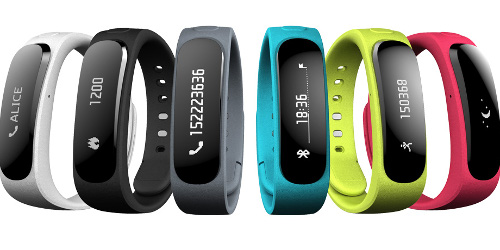
1. See-through dress

Netherlands-based Studio Roosegaarde has created a smart dress called Intimacy that claims to become see-through when its wearers get "turned on".
The new Intimacy 2.0 dress is made of leather and smart electronic foils that are wired with LEDs, while sensors hidden throughout the dress are able to detect tiny changes in the wearer’s body temperature and heart rate.
The dress gradually becomes more see-through as its wearer’s heartbeat increases, meaning that fear, excitement and anxiety may also cause the user to show more expose.
Award-winning Dutch designer Daan Roosegaarde said: "Technology is used here not merely functional but also as a tool to create intimacy as well as privacy on a direct, personal level which in our contemporary tech society is becoming increasingly important."
The design company has created two versions of the dress already, and is currently searching for haute-couture designers to develop a third, called Intimacy 3.0.
2. Solar-powered clothing

Photo source: Mike Nicolaassen, Pauline van Dongen
Dutch designer Pauline van Dongen is creating dresses and coats that she claims can power a smartphone and other gadgets.
Van Dongen’s outfits, called Wearable Solar, are said to be equipped with solar panels to make sure users can re-charge their mobile device when an electric socket is not available.
Entrepreneur Christian Holland came up with the idea when he imagined how people who attend outdoor music festivals needed to charge their mobile devices.
The clothes are still in the prototype phase and most likely will not be on the market for another two years.
3. Safety bracelet

Cuff, a San Francisco-based startup, has released a collection of bracelets, necklaces and key chains that it claims keep users safe.
There is an accompanying waterproof black tracker called Cufflinc that slots into any of the jewellery and links to a smartphone app via Bluetooth.
The device would allow users to send alerts out to family or friends in an emergency or simply let them know when they’re trying to get in touch.
Deepa Sood, co-founder of Cuff, in a statement said: "The new Cuff collection wearables are more chic than geek, wrapping smart technology into elegant, fashionable pieces that we all WANT to wear."
"We don’t believe that we should be forced to choose between smarts and beauty when it comes to wearable accessories."
The device, which costs between £30 and £100, is currently available for pre-order with shipments starting later this year.
3. Safety bracelet

Cuff, a San Francisco-based startup, has released a collection of bracelets, necklaces and key chains that it claims keep users safe.
There is an accompanying waterproof black tracker called Cufflinc that slots into any of the jewellery and links to a smartphone app via Bluetooth.
The device would allow users to send alerts out to family or friends in an emergency or simply let them know when they’re trying to get in touch.
Deepa Sood, co-founder of Cuff, in a statement said: "The new Cuff collection wearables are more chic than geek, wrapping smart technology into elegant, fashionable pieces that we all WANT to wear."
"We don’t believe that we should be forced to choose between smarts and beauty when it comes to wearable accessories."
The device, which costs between £30 and £100, is currently available for pre-order with shipments starting later this year.
4. Heart sensor bracelet

Canadian firm Bionym’s Nymi bracelet reads the unique pattern in people’s heartbeat to confirm who they are.
The bracelet has a built-in sensor to detect where they are and a HeartID that measures the cardiac rhythm tracked on an electrocardiogram, which differs from person to person.
It works by taking an electrocardiogram when the wearer touches it with the opposite hand, which then broadcasts a signal to a matching computer, device or car that confirms his or her identity and unlocks it.
Bionym hopes the hype around fingerprint scanning created when Apple unveiled its iPhone 5S will create excitement around the Nymi.
5. Smart glasses

Photo source: Vuzix
Vuzix, a New York-based startup, released M100 smart glasses at this year’s Consumer Electronics Show (CES) in Las Vegas that it claims are well suited for a variety of industrial, medical and retail applications.
The $900 smart glasses, which were awarded a Best of CES innovation award, run on the Android operating system and the unit and display fit over the user’s right ear and eye.
Once the device is hooked up to your tablet or smartphone, it can record and playback videos, surf the web, take photos, track timed events and check emails.
6. Oculus Rift
![]()
Photo source: OculusVR
Designed almost exclusively for gamers, the Oculus goggles immerse the wearer into a 3D virtual reality (VR) fantasy that allows them to navigate games and other experiences with just the movement of their heads.
The ski-like-goggles, codenamed Crystal Cove, have sensors and a camera designed to track the position of both your head and body, and provide a more accurate simulated movement.
The latest version of Oculus’s 3D headset has a 960x 1,080 OLED display, which Oculus says is larger than a smartphone but smaller than a tablet, and is already being explored for PTSD therapy, helping people who have lost an arm or leg, to controlling robots avatars and soldiers.
7. Morpheus headset

Photo source: Sony Computer Entertainment
Japanese giant Sony also unveiled Project Morpheus, another VR headset to rival Oculus Rift, which features a 1080p display with a 90 degree field of view and full 360 degree turning as well as accelerometer and gyroscope sensors to pick up the movement of your head, translating the movements onto a screen.
The Associated Press said the headset felt "secure" thanks to a sturdy yet comfortable halo-like ring that snaps into place around the head.
Sony said the current version of the technology works alongside the Play Station 4 console to display imagery on the headset’s screen with a cord that’s approximately 15ft (4.5 metres) long.
There are no details about price or availability.
8. Talkband 1

Photo source: Huawei
Chinese telecoms and IT giant Huawei released its hybrid Talkband 1 in February 2014, which is a waterproof band to track fitness.
The $99 band also allows users to make calls from their wrist once it connects to any Android or iOS smart device.
Talkband 1 also comes with a 1.4-inch flexible display, built-in GPS and a Bluetooth earpiece, which is hidden inside the band.
9. Pebble Steel

Photo source: Pebble
Designed to be a classier version of the original Pebble model released in 2012, Pebble Steel has ditched the polycarbonate and silicon plastic in favour of stainless steel or matte black designs.
Both of the designs, which are thinner and smaller than before, come with two straps, so you can match it to what you’re wearing.
While the model still features the low-power E Ink display, it now has protective Gorilla Glass 2 on the screen, with a small LED notification light in the corner.
Users download the Pebble app to their Android or iOS device and use Bluetooth to synchronise the watch with their smartphone. This way, it can notify you on phone calls, emails, texts and updates from your social media world without having to check your phone.
The software can store up to eight apps at once, while previously loaded apps that are currently unused are added to your Locker, which are sorted by their most recent use.
10. Gear

Photo source: Samsung Mobile Press
Samsung launched two successors to its Galaxy Gear smartwatch at Mobile World Congress (MWC) in February 2014: the Gear 2 and Gear 2 Neo.
The watches are designed to be sleeker and lighter than Samsung’s original £300 Galaxy Gear, which was criticised for having only a single day of battery life, a limited selection of apps and a clunky camera.
They’re also dustproof and water-resistant, and feature a 300mAh battery with up to three days of standby time, a built-in speaker and mic, 4GB of storage, and a heart rate sensor and pedometer to measure stress levels, sleep and exercise (with or without a smartphone).
The watches are meant to act as a companion device for about 16 of Samsung’s Galaxy smartphones and tablets. Calls can be taken via the wrist, while the screen notifies users on incoming emails, phone calls, text messages and social media updates without having to check their phone.






